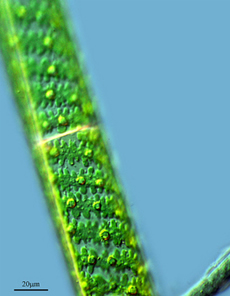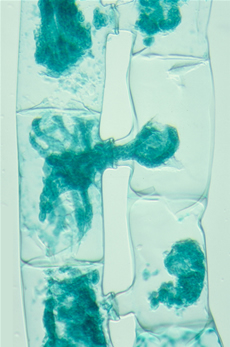Agriculture
It is almost impossible not to see Spirogyra floating on the surface of a pond on a hot summer day, but most people dismiss it as pond scum. Few realize that what they are looking at is a member of the Charophyceae, a class in the phylum Chlorophyta, or green algae, and a cousin of the ancestor of the Embryophyta, or bryophytes and vascular plants.
Most Charophyceae, like Spirogyra, live in freshwater habitats, but some also occur in moist soil in terrestrial habitats. Charophyceae can live as single cells, colonies, or branched and unbranched filaments and come in a variety of shapes.
The characteristics that unite members of the class?and which link them with the embryophytes?include flagellated cells (similar to sperm cells in vascular plants), a nuclear envelope that breaks down during mitosis, mitotic spindles that persist as phragmoplasts (a type of cytoskeletal scaffolding) through cell division either by furrowing or by forming a cell plate, the presence of chlorophylls a and b and phytochrome, and the storage of starch inside plastids.
Charophytes possess decay-resistant cell walls made of phenolic compounds as well as lignins or ligninlike compounds. Cell walls made of similar compounds are found in bryophytes and vascular plants as well.
Likewise, all three groups of plants also contain sporopollenin, the substance in the walls of spores and pollen grains that makes them virtually indestructible.
Communication channels between cells are similar, too. Plasmodesmata similar to that seen in embryophyte cells allow between-cell communications in charophytes and embryophytes.
Life Cycle
 Charophytes have a two-stage life cycle involving a dominant haploid stage, upon which develops the sex organs; antheridia, which produce sperm cells; and oogonia, which produce egg cells. Typically, individual charophytes produce both antheridia and oogonia, but in some species an individual will produce only one or the other.
Charophytes have a two-stage life cycle involving a dominant haploid stage, upon which develops the sex organs; antheridia, which produce sperm cells; and oogonia, which produce egg cells. Typically, individual charophytes produce both antheridia and oogonia, but in some species an individual will produce only one or the other.
Fertilization?which in one group, the Zygnematales, takes place via conjugation?produces a diploid zygote, which quickly undergoes meiosis. If the environment is unfavorable, the zygote will go dormant and remain so for a long period of time. Dormancy ends when the environment improves.
Classification
Genetic analysis supports the recognition of six orders within the Charophyceae: the Mesostigmatales, Chlorokybales, Klebsormidiales, Zygnematales, Coleochaetales, and Charales.
Of these, the most abundant group is the Zygnematales, a large order which consists of more than three thousand species, including Spirogyra and the desmids, a group of mostly single-celled organisms with a constriction across the middle which nearly divides the cells in two.
Zygnematales live primarily in freshwater habitats as phytoplankton, as benthic dwellers, or attached to other aquatic plants. Some species live on snow and ice.
The Charales, commonly called stoneworts or brittleworts, are a large group of filamentous charophytes that feature complex branching patterns. Some can reach lengths of more than a meter. The branching pattern?branches reach out from nodes along the filament?is similar to that of higher plants.
 Charales reside primarily in freshwater habitats, but some can be found in brackish water as well as on land. The stems of stoneworts and brittleworts can be encrusted with calcium and magnesium carbonates.
Charales reside primarily in freshwater habitats, but some can be found in brackish water as well as on land. The stems of stoneworts and brittleworts can be encrusted with calcium and magnesium carbonates.
As a result, their hard bodies are well known from the fossil record. The lineage extends back to more than 400 million years ago. Two current genera, Chara and Nitella, date back about 200 million years.
The Coleochaetales are a small group of complex, microscopic filamentous algae that can be found only in freshwater habitats. Klebsormidiales are a small group of unbranched, filamentous charophytes that occur in both freshwater and terrestrial environments.
Mesostigmatales and Chlorokybales are two groups of rare algae. The Coleochaetales and Charales are more closely related to bryophytes and vascular plants than the other groups.
Evolutionary Significance
For decades, structural similarities led plant biologists to suspect that the Embryophyta evolved from charophytes. Recently, cladistic analyses of chemical, structural, and genetic characteristics have opened up research on the topic.
In cladistics, characteristics among a number of organisms are analyzed statistically in the hopes of developing a classification system for the group which will reveal evolutionary relationships. Cladistic analyses support the notion that embryophytes are monophyletic; in other words, bryophytes and vascular plants descend from a common ancestor.
Furthermore, several recent analyses support the notion that a member of the Charophyceae gave rise to embryophytes. Cladistic analyses were somewhat unclear, however, about the relationships of the charophyte orders with one another and with other green algae (Chlorophyta), bryophytes, and land plants.
One of the latest analyses of mitochondrial, chloroplast, and nuclear genes helps resolve some of the confusion. The research indicates that the Mesostigmatales were probably the most ancient group of charophytes, followed by the Chlorokybales, Klebsormidiales, Zygnematales, Coleochaetales, and Charales.
The work also supports earlier suggestions that the Charales are the closest living relatives to extant embryophytes and that the charophytes descended from other green algae.
- Bryophytes
BryophytesBryophytes comprise three phyla of nonvascular plants, which generally lack the specialized conductive tissues (xylem and phloem) that are found in the vascular plants, are small in size, and are distributed worldwide in moist, shady habitats....
- Chlorophyceae
ChlorophyceaeChlorophyceae (from the Greek word chloros, meaning ?green?) make up an extremely large and important class of green algae. Members may be unicellular, colonial, or filamentous. Cells of unicellular and colonial chlorophyceans may have two...
- Euglenoids
Euglenoids Organisms called euglenoids, the algal phylum Euglenophyta in the kingdom Protista, make up a large group of common microorganisms numbering between 750 and 900 known species. Euglenoids can be found in both fresh and stagnant water. Some genera...
- Eukarya
EukaryaThe Eukarya form one of the domains of life in the three-domain classification system. Eukarya consists of the advanced, complex organisms, formed by eukaryotic cells (cells with nuclei), including fungi, algae, plants, and animals. The other two...
- Reproduction In Plants
Reproduction in Plants Plants have evolved a remarkable number of ways to increase their numbers. These include not only a variety of forms of sexual reproduction, in which two individuals produce specialized cells that fuse to become a new offspring,...
Agriculture
Charophyceae
 |
| Charophyceae |
Most Charophyceae, like Spirogyra, live in freshwater habitats, but some also occur in moist soil in terrestrial habitats. Charophyceae can live as single cells, colonies, or branched and unbranched filaments and come in a variety of shapes.
The characteristics that unite members of the class?and which link them with the embryophytes?include flagellated cells (similar to sperm cells in vascular plants), a nuclear envelope that breaks down during mitosis, mitotic spindles that persist as phragmoplasts (a type of cytoskeletal scaffolding) through cell division either by furrowing or by forming a cell plate, the presence of chlorophylls a and b and phytochrome, and the storage of starch inside plastids.
Charophytes possess decay-resistant cell walls made of phenolic compounds as well as lignins or ligninlike compounds. Cell walls made of similar compounds are found in bryophytes and vascular plants as well.
Likewise, all three groups of plants also contain sporopollenin, the substance in the walls of spores and pollen grains that makes them virtually indestructible.
Communication channels between cells are similar, too. Plasmodesmata similar to that seen in embryophyte cells allow between-cell communications in charophytes and embryophytes.
Life Cycle

Fertilization?which in one group, the Zygnematales, takes place via conjugation?produces a diploid zygote, which quickly undergoes meiosis. If the environment is unfavorable, the zygote will go dormant and remain so for a long period of time. Dormancy ends when the environment improves.
Classification
Genetic analysis supports the recognition of six orders within the Charophyceae: the Mesostigmatales, Chlorokybales, Klebsormidiales, Zygnematales, Coleochaetales, and Charales.
Of these, the most abundant group is the Zygnematales, a large order which consists of more than three thousand species, including Spirogyra and the desmids, a group of mostly single-celled organisms with a constriction across the middle which nearly divides the cells in two.
Zygnematales live primarily in freshwater habitats as phytoplankton, as benthic dwellers, or attached to other aquatic plants. Some species live on snow and ice.
The Charales, commonly called stoneworts or brittleworts, are a large group of filamentous charophytes that feature complex branching patterns. Some can reach lengths of more than a meter. The branching pattern?branches reach out from nodes along the filament?is similar to that of higher plants.

As a result, their hard bodies are well known from the fossil record. The lineage extends back to more than 400 million years ago. Two current genera, Chara and Nitella, date back about 200 million years.
The Coleochaetales are a small group of complex, microscopic filamentous algae that can be found only in freshwater habitats. Klebsormidiales are a small group of unbranched, filamentous charophytes that occur in both freshwater and terrestrial environments.
Mesostigmatales and Chlorokybales are two groups of rare algae. The Coleochaetales and Charales are more closely related to bryophytes and vascular plants than the other groups.
Evolutionary Significance
For decades, structural similarities led plant biologists to suspect that the Embryophyta evolved from charophytes. Recently, cladistic analyses of chemical, structural, and genetic characteristics have opened up research on the topic.
In cladistics, characteristics among a number of organisms are analyzed statistically in the hopes of developing a classification system for the group which will reveal evolutionary relationships. Cladistic analyses support the notion that embryophytes are monophyletic; in other words, bryophytes and vascular plants descend from a common ancestor.
Furthermore, several recent analyses support the notion that a member of the Charophyceae gave rise to embryophytes. Cladistic analyses were somewhat unclear, however, about the relationships of the charophyte orders with one another and with other green algae (Chlorophyta), bryophytes, and land plants.
One of the latest analyses of mitochondrial, chloroplast, and nuclear genes helps resolve some of the confusion. The research indicates that the Mesostigmatales were probably the most ancient group of charophytes, followed by the Chlorokybales, Klebsormidiales, Zygnematales, Coleochaetales, and Charales.
The work also supports earlier suggestions that the Charales are the closest living relatives to extant embryophytes and that the charophytes descended from other green algae.
 |
| wine making made easy |
- Bryophytes
BryophytesBryophytes comprise three phyla of nonvascular plants, which generally lack the specialized conductive tissues (xylem and phloem) that are found in the vascular plants, are small in size, and are distributed worldwide in moist, shady habitats....
- Chlorophyceae
ChlorophyceaeChlorophyceae (from the Greek word chloros, meaning ?green?) make up an extremely large and important class of green algae. Members may be unicellular, colonial, or filamentous. Cells of unicellular and colonial chlorophyceans may have two...
- Euglenoids
Euglenoids Organisms called euglenoids, the algal phylum Euglenophyta in the kingdom Protista, make up a large group of common microorganisms numbering between 750 and 900 known species. Euglenoids can be found in both fresh and stagnant water. Some genera...
- Eukarya
EukaryaThe Eukarya form one of the domains of life in the three-domain classification system. Eukarya consists of the advanced, complex organisms, formed by eukaryotic cells (cells with nuclei), including fungi, algae, plants, and animals. The other two...
- Reproduction In Plants
Reproduction in Plants Plants have evolved a remarkable number of ways to increase their numbers. These include not only a variety of forms of sexual reproduction, in which two individuals produce specialized cells that fuse to become a new offspring,...
